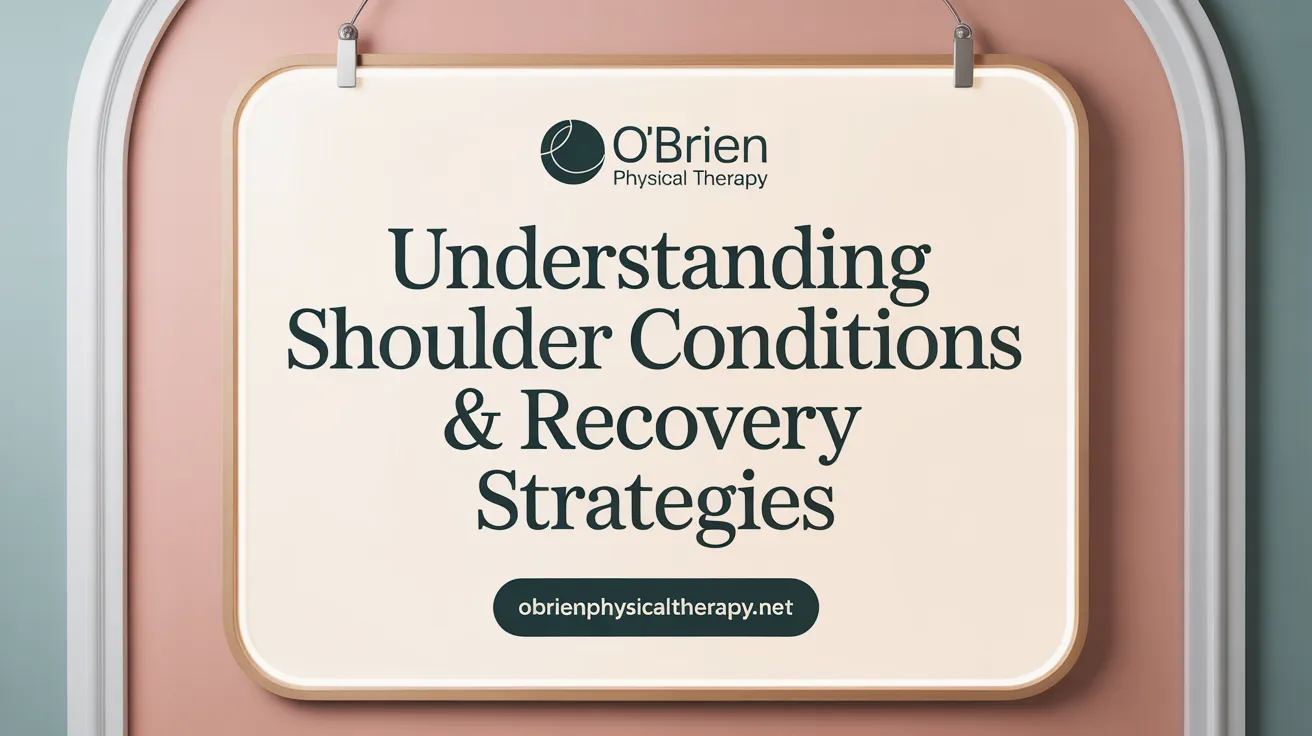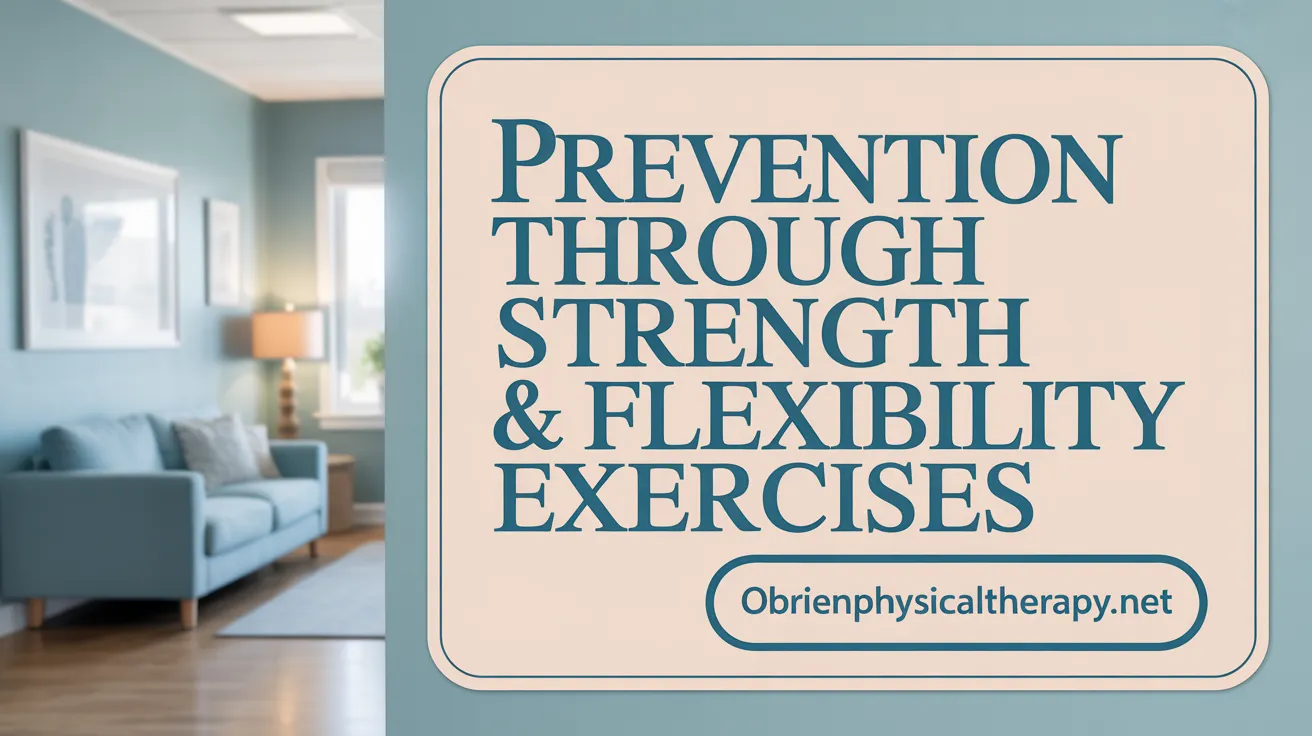Understanding Shoulder Mobility and Its Importance After Injury
Shoulder injuries and surgeries often lead to reduced mobility, stiffness, and pain, affecting daily activities and overall quality of life. Restoring shoulder function involves more than healing; it requires targeted rehabilitation exercises that improve flexibility, strength, and joint stability. This article explores effective strategies, exercises, and precautions necessary for regaining optimal shoulder mobility post-injury, empowering readers with practical guidance to support their recovery journey safely and effectively.
Effective Rehabilitation Exercises to Restore Shoulder Mobility
 After experiencing shoulder injury or surgery, implementing a structured set of rehabilitation exercises is crucial for restoring mobility and preventing future issues. In the early stages of recovery, gentle movements such as pendulum swings exercise help maintain joint flexibility without putting stress on healing tissues. These are followed by passive range-of-motion exercises like passive internal and external rotation, often performed with the support of a towel or on a wall, to gently stretch and mobilize the shoulder.
After experiencing shoulder injury or surgery, implementing a structured set of rehabilitation exercises is crucial for restoring mobility and preventing future issues. In the early stages of recovery, gentle movements such as pendulum swings exercise help maintain joint flexibility without putting stress on healing tissues. These are followed by passive range-of-motion exercises like passive internal and external rotation, often performed with the support of a towel or on a wall, to gently stretch and mobilize the shoulder.
As the shoulder begins to regain more movement, targeted stretches such as the cross-over arm stretch technique and sleeper stretch for shoulder become beneficial. These stretches enhance flexibility in the shoulder capsule and rotator cuff muscles, essential for normal arm movement. Incorporating resisted rotations with resistance bands also helps strengthen the rotator cuff muscles, providing stability to the joint.
Scapula stabilization exercises, such as scapula setting and retraction, are vital for proper shoulder function, as they promote correct posture and muscle activation around the shoulder blades.
It is important to progress slowly, starting with low repetitions and gradually increasing as comfort level and strength improve. Always perform exercises within a pain-free range, avoiding any movements that cause discomfort or worsen symptoms.
Consistency and precise technique are key to successful rehabilitation. Consulting with a healthcare professional, such as a physical therapist, ensures exercises are tailored to individual needs and are performed safely. By adhering to these principles, patients can effectively regain shoulder mobility, improve strength, and support long-term shoulder health.
Safe Techniques for Performing Shoulder Mobility Exercises
To perform shoulder mobility exercises safely and effectively, it is essential to follow proper techniques that prioritize safety and support recovery. Begin each session with a gentle warm-up, such as arm circles, arm swings, or dynamic stretches, lasting about 5-10 minutes. This active preparation increases blood flow to the shoulder muscles and joints, reducing the risk of strains.
Incorporate controlled and deliberate movements throughout your exercises. Avoid rapid or jerky motions, and focus on smooth, steady control. Paying attention to posture is crucial; keep your shoulders aligned and avoid arching or slouching, which can strain the neck or lower back.
Monitoring pain levels is vital. Exercises should be performed within a pain-free range, ideally generating no more than a moderate discomfort (pain rating of 0-5 out of 10). Stop or modify any movement that causes increased pain or abnormal sensations. Refer to pain and exercise caution guidelines for more details.
Gradually increase the intensity and range of motion over time. Start with small repetitions, such as 2-3 reps, and progress to more sets or greater movement displacement as tolerated. This gradual approach helps prevent overstretching or aggravating healed tissues. For program duration and progression, see the 4-6 week shoulder program duration.
Integrate specific stretches like the cross-arm stretch, sleeper stretch, and doorway stretch to improve flexibility in tight muscles, reducing stiffness and facilitating movement.
Consider helpful mobility exercises such as shoulder pass-throughs, scapular retraction, and gentle external rotations to enhance joint mobility. Exercises like standing row and resistance band shoulder rotations may also be beneficial.
Always seek guidance from a healthcare professional or physical therapist, especially if you are recovering from injury or surgery. Their advice ensures exercises are tailored to your individual needs and condition. For professional guidance and rehabilitation plans, consult resources like post-injury shoulder rehabilitation advice and consultation for exercise pain.
In summary, safe shoulder mobility exercises involve a proper warm-up, controlled movements, attention to posture, pain monitoring, slow progression, and professional consultation. These practices help promote recovery, prevent injury, and improve overall shoulder function.
Structuring Shoulder Exercise Routines and Stretches During Recovery
When recovering from a shoulder injury or surgery, adhering to a well-structured exercise routine is essential for restoring mobility, strength, and stability. A balanced approach combines gentle warm-up, targeted stretching, and strengthening exercises performed under professional guidance to optimize healing. For detailed programs, see the Rotator Cuff and Shoulder Conditioning Program.
Start your routine with a warm-up phase, lasting about 5-10 minutes, engaging in low-impact activities such as walking, stationary cycling, or arm circles. This increases blood flow and prepares the shoulder muscles for movement, reducing the risk of further injury.
Following warm-up, incorporate stretching exercises like Pendulum swings, Cross-arm stretches, Sleeper stretches, and doorway shoulder stretches. These help preserve and improve flexibility, prevent stiffness, and maintain range of motion. Be attentive to your body's response; stretches should promote tension but not pain, and should be held gently within a comfortable zone. More on stretching can be found at Best Shoulder Stretches.
Once flexibility is maintained, gradually progress to strengthening exercises. Common options include rows, shoulder rotations with resistance bands or weights, scapular setting, and isometric holds. Begin with low repetitions, such as 8-12, and perform 2-3 sets, gradually increasing repetitions and resistance as tolerated. Exercises for strengthening and conditioning are detailed in the Shoulder Strengthening Exercises Guide.
The frequency of exercises is typically 2-3 times per week, allowing sufficient recovery time between sessions. Consistency is vital to promote tissue healing and prevent setbacks. For exercise planning and safety tips, see Exercise Frequency for Shoulder Maintenance.
To avoid aggravating your injury, always listen to your body. Discontinue any exercise that causes pain beyond mild discomfort (rated 0-3 on a 10-point scale) and consult a healthcare professional if symptoms worsen or persist beyond six weeks. Guidelines on pain management and when to seek help are available at Managing Shoulder Exercise Pain.
Progressive overload—carefully increasing exercise intensity, resistance, or duration—is important but should be done gradually to build strength without risking re-injury. Recommendations for gradual progression are explained in Post-injury Shoulder Rehabilitation Advice.
Professional supervision, especially in the early stages of rehabilitation, can ensure proper technique and personalized adjustments. A physical therapist can tailor exercises to your specific needs, monitor progress, and provide encouragement. More resources on professional guidance are at Consultation for Exercise Pain.
In sum, a safe and effective shoulder recovery routine involves warm-up, flexibility exercises, gradual strength rebuilding, regular frequency, pain monitoring, and professional guidance to support optimal healing and functional recovery. For a comprehensive structured shoulder conditioning program, please visit this resource.
Common Shoulder Conditions Affecting Mobility and Exercise Interventions
 Several shoulder conditions can impact mobility and daily function, often resulting in pain, stiffness, and restricted movement. Among the most prevalent are impingement syndrome, frozen shoulder, rotator cuff injuries, and arthritis.
Several shoulder conditions can impact mobility and daily function, often resulting in pain, stiffness, and restricted movement. Among the most prevalent are impingement syndrome, frozen shoulder, rotator cuff injuries, and arthritis.
Impingement syndrome, also called subacromial pain syndrome, occurs when shoulder tissues like tendons and bursa are compressed during arm movements, causing pain, especially with overhead activities. Regular exercises such as Isometric Shoulder Internal Rotation and Shoulder Scaption Exercise can strengthen the rotator cuff and improve shoulder support, reducing impingement symptoms.
Frozen shoulder, or adhesive capsulitis, involves thickening and tightening of the joint capsule, leading to significant stiffness and limited range of motion. Gentle stretching exercises, including Pendulum Swings Exercise and Cross-Body Shoulder Stretch, help restore flexibility. As healing progresses, controlled strengthening can be added to recover normal shoulder function.
Rotator cuff injuries encompass tendinopathy and tears that weaken shoulder stability and cause pain. Exercises targeting the rotator cuff, like External Rotation Exercises and Scapular Stability Workouts, enhance muscle support and neuromuscular control, aiding in pain relief and functional improvements.
Arthritis in the shoulder joint results from cartilage degeneration, leading to pain and reduced mobility. Maintaining flexibility through Daily Shoulder Stretching Routines and gentle strengthening exercises can alleviate discomfort and improve joint function.
Pain and stiffness from these conditions limit daily activities, but targeted Shoulder Conditioning and Rehabilitation Exercises offer significant benefits. They promote blood flow to injured tissues, support proper movement patterns, and strengthen muscles around the joint. Importantly, rehabilitation programs must be tailored individually, often under professional supervision, to ensure safe progression and optimal recovery.
Incorporating mobility and strengthening exercises into a consistent routine can prevent further deterioration, reduce dependency on medications, and minimize surgical intervention needs. Guided by healthcare professionals, these exercises foster shoulder stability, restore range of motion, and help patients regain confidence in their shoulder's function for everyday life and athletic pursuits.
Targeted Muscle Groups for Effective Shoulder Recovery and Stabilization
When aiming for optimal recovery and stability of the shoulder, it is crucial to focus on specific muscle groups that support shoulder movement and joint integrity.
The primary muscles involved include the rotator cuff group, which comprises the supraspinatus, infraspinatus, subscapularis, and teres minor. These muscles are essential for stabilizing the glenohumeral joint, especially during dynamic movements. For detailed rotator cuff and shoulder conditioning program, refer to professional guidance.
Additionally, the deltoids, particularly the anterior portion, play a vital role in lifting and arm abduction. Strengthening the deltoids helps restore shoulder power and facilitates functional movements. Learn about deltoids and trapezius training for effective strengthening exercises.
Scapular stabilizers such as the trapezius, serratus anterior, and rhomboids are also integral to maintaining proper shoulder blade positioning. These muscles support scapular mobility and stability, which are critical for smooth shoulder mechanics. Explore scapular exercises for shoulder health to improve scapular stability.
Incorporating stretching and strengthening exercises targeting these muscles can effectively promote tissue healing and improve overall shoulder function. For example, stretches for the pectoralis major, latissimus dorsi, levator scapulae, and trapezius can restore flexibility and range of motion. Visit best shoulder stretches and flexibility exercises for comprehensive stretching routines.
A balanced program includes gradual resistance training—using resistance bands, weights, or body weight—to ensure muscle strength development aligns with recovery goals. Proper technique, progression, and pain monitoring are vital components of a successful rehabilitation plan. See guided shoulder exercise programs for safe progression and pain management tips.
Engaging these targeted muscle groups through comprehensive exercise routines enhances joint stability, reduces the risk of re-injury, and supports long-term shoulder health. Collaborating with healthcare professionals ensures exercises are tailored to individual needs, promoting safe and effective recovery. For professional advice and personalized plans, consult resources on post-injury shoulder rehabilitation and strengthening.
Strategies to Improve Shoulder Function, Strength, and Flexibility Post-Injury
Recovering shoulder health after an injury or surgery requires a well-rounded approach that combines various exercises, routines, and professional guidance. A comprehensive rehabilitation program is crucial for restoring shoulder stability, mobility, and strength.
Implementing mobility and strengthening exercises forms the core of effective recovery. Exercises like pendulum swings, wall slides, and thoracic extensions help enhance joint flexibility. Strengthening muscles such as the rotator cuff, deltoids, trapezius, and scapular stabilizers with resistance bands, light weights, or bodyweight exercises ensures the joint is supported properly.
Stretching routines are also vital. Regular stretches such as cross-body arm stretches, sleeper stretches, and tricep stretches aid in restoring the shoulder’s range of motion and prevent stiffness. Incorporating these stretches after warm-up and post-strengthening exercises maintains flexibility and facilitates better movement.
Warm-up activities are essential to prepare the muscles and joints for exercise. Light activities like walking, stationary cycling, or dynamic upper body movements help increase blood flow and reduce injury risk. Gradual progression in resistance and complexity of exercises, emphasizing proper technique, ensures safe and steady improvement. Suggested warm-up exercises include dynamic upper body stretches and arm swings.
Lifelong maintenance involves performing targeted exercises 2-3 times a week even after initial recovery. This ongoing routine helps sustain shoulder health, flexibility, and strength, as outlined in the rotator cuff and shoulder conditioning program.
Collaborating with healthcare professionals, such as physical therapists, offers personalized guidance, ensuring exercises are performed correctly and safely. Their expertise is invaluable in designing a tailored rehab plan that minimizes the risk of re-injury while maximizing functional outcomes. For professional supervision and individualized programs, see shoulder stability exercises for post-injury recovery.
In summary, combining mobility and strengthening exercises, stretching routines, proper warm-up, progressive overload, and professional supervision creates an effective strategy for improving shoulder function, strength, and flexibility following injury.
Step-by-Step Shoulder Rehabilitation Routine for Optimal Recovery
 A comprehensive shoulder rehabilitation routine begins with gentle warm-up activities such as low-impact exercises like walking or stationary cycling for 5-10 minutes. This helps increase blood flow and prepares the muscles for activity. Once warmed up, proceed to the stretching phase, which includes pendulum swings, cross-body stretches, sleeper stretches, and passive internal and external rotations. These exercises aim to restore shoulder range of motion and reduce stiffness.
A comprehensive shoulder rehabilitation routine begins with gentle warm-up activities such as low-impact exercises like walking or stationary cycling for 5-10 minutes. This helps increase blood flow and prepares the muscles for activity. Once warmed up, proceed to the stretching phase, which includes pendulum swings, cross-body stretches, sleeper stretches, and passive internal and external rotations. These exercises aim to restore shoulder range of motion and reduce stiffness.
Following flexibility exercises, focus on strengthening muscles that support the shoulder, including the rotator cuff muscles, deltoids, and scapular stabilizers such as the trapezius and rhomboids. Use resistance bands for external and internal rotations, perform rows, scapular squeezes, and wall slides. These exercises should be performed with controlled movements, emphasizing good posture and proper muscle activation, as described in the Rotator Cuff and Shoulder Conditioning Program and Evidence Based Shoulder Exercises.
Scapular stabilization is a vital part of recovery. Incorporate targeted drills like scapular retraction, upward rotation, and shoulder blade squeezes, which help improve shoulder joint stability and prevent future injuries, as highlighted in Shoulder Stability Exercises for Post-Injury Recovery.
It’s essential to progress gradually, increasing resistance, repetitions, or exercise complexity only as tolerated and without causing pain. Initially, aim for 2-3 sets of 8-15 repetitions, adjusting based on comfort. Over the 4-6 week period, aim to increase exercise difficulty incrementally, always monitoring pain and fatigue, consistent with protocols outlined in the Shoulder Rehab Program Guidelines.
Precautions include avoiding exercises that cause sharp or worsening pain, and stopping if discomfort exceeds a manageable level (pain rated 0-5 out of 10). Consulting with a healthcare provider or physical therapist ensures exercises remain tailored to individual recovery stages, as recommended by NHS Inform Shoulder Exercises Advice.
With consistent supervision and proper technique, this routine promotes optimal healing, restores shoulder mobility, and helps return to daily activities or sports efficiently. For additional guidance and detailed exercise instruction, see the Rotator Cuff and Shoulder Conditioning Program and Shoulder Mobility Exercises.
Preventing Shoulder Injuries Through Mobility and Stability Exercises
 Shoulder exercises play a vital role in injury prevention by enhancing the strength and stability of the shoulder joint. Targeted movements transfer load away from vulnerable structures, strengthening muscles such as the rotator cuff and scapular stabilizers, and upper back muscles. This support maintains proper alignment and prevents abnormal joint stresses that can lead to impingement or tears.
Shoulder exercises play a vital role in injury prevention by enhancing the strength and stability of the shoulder joint. Targeted movements transfer load away from vulnerable structures, strengthening muscles such as the rotator cuff and scapular stabilizers, and upper back muscles. This support maintains proper alignment and prevents abnormal joint stresses that can lead to impingement or tears.
Improving flexibility through stretching exercises reduces stiffness, helping the shoulder move smoothly and naturally. Increased range of motion minimizes the risk of compensatory movements that often cause strain or injury.
Moreover, neuromuscular control training enhances coordination between muscles and nerves, ensuring correct movement patterns. This motor control is essential in reproducing safe, functional motions during everyday activities and sports.
Progressive overload, gradually increasing exercise intensity and complexity, builds tissue resilience and muscular endurance. Consistent challenge to the shoulder’s supportive structures helps prevent fatigue-related injuries.
Developing resilience and strength through tailored exercise programs fosters robust, injury-resistant shoulders. Maintaining good posture and proper alignment during lifting and daily movements further supports shoulder health.
By integrating strengthening, stretching, neuromuscular training, and posture correction, shoulder exercises significantly contribute to injury prevention, preserve joint health, and improve overall functional performance for active individuals.
Key Mobility Exercises and Stretches to Enhance Flexibility and Reduce Pain

Dynamic warm-up exercises are essential in preparing the shoulder muscles and joints for more targeted mobility work. Incorporating movements such as arm swings and shoulder pass-throughs can significantly increase blood flow, loosen tight muscles, and improve joint lubrication.
Arm swings are simple yet effective exercises that involve swinging your arms forward, backward, and across your body. These movements help increase shoulder joint range of motion and prepare your muscles for subsequent stretching or strengthening routines.
Shoulder pass-throughs are performed using a stick, resistance band, or towel, where you hold the object with both hands and gently move it over your head and behind your back. This exercise enhances shoulder flexibility, especially in external rotation and abduction, which are vital for daily movements and injury prevention.
Cross-arm stretches effectively target the posterior shoulder muscles and upper back. To perform this stretch, bring one arm across your chest and hold it with the opposite arm, gently pulling to increase shoulder flexibility. Regular practice can relieve tension and improve range of motion. Try the Cross-Arm Stretch technique for better results.
The sleeper stretch is specifically designed to improve internal rotation. Lie on your side with the arm you're stretching perpendicular to your body, then use your opposite hand to gently press the wrist downward. This stretch is particularly beneficial for shoulder impingement sufferers. Refer to the Sleeper Stretch for shoulder for guidance.
The doorway stretch involves standing in a doorway with arms at a 90-degree angle, gently leaning forward to feel a stretch across the front of the shoulders and chest. This helps increase flexibility in the pectoral muscles and shoulder capsule. Learn more about Doorway Stretch.
Child’s pose, although a yoga pose, is very effective for shoulder mobility. Start on hands and knees, then sit back onto your heels while reaching your arms forward on the ground. This stretch decompresses the shoulders and thoracic spine, easing tension. See Child's Pose for Shoulders for details.
YTWL exercises involve lying on your stomach and lifting your arms into various positions resembling the letters Y, T, W, and L. These movements activate and strengthen the scapular stabilizers, essential for maintaining proper shoulder mechanics. For more on scapular exercises, visit Scapular Muscle Activation.
Performing these exercises and stretches regularly, ideally 2-3 times per week, can significantly enhance shoulder flexibility, reduce stiffness, and lower the risk of injury. Remember, always listen to your body, and consult a healthcare professional if you experience pain or discomfort during these activities. For comprehensive guidance, see the Rotator Cuff and Shoulder Conditioning Program.
Pathway to Regaining Shoulder Health and Mobility
Regaining shoulder mobility after injury or surgery demands a well-structured approach combining gentle mobility work, targeted strengthening, and consistent stretching. Tailoring exercises to individual needs and pain thresholds, along with professional supervision, ensures safe progression and optimizes outcomes. Emphasizing muscles that stabilize the shoulder joint and maintaining long-term exercise habits can prevent re-injury and support daily function and athletic performance. Remember, patience and dedication to these rehabilitation strategies pave the way towards restored shoulder health, improved quality of life, and confidence in movement.
